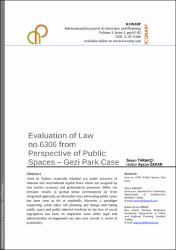| dc.contributor.author | Tarakçı, Sezen | en_US |
| dc.contributor.author | Özkan, Hatice Aysun | en_US |
| dc.date.accessioned | 2019-10-29T17:32:43Z | |
| dc.date.available | 2019-10-29T17:32:43Z | |
| dc.date.issued | 2015 | |
| dc.identifier.issn | 2147-9380 | |
| dc.identifier.uri | https://hdl.handle.net/20.500.12294/1819 | |
| dc.description | WOS: 000453089500004 | en_US |
| dc.description.abstract | Cities in Turkey, especially Istanbul are under pressure of national and international capital flows which are assigned by free market economy and globalization processes. While the pressure results in partial urban development far from integrated approach, an alternative idea advocating public space has been seen as tilt at windmills. However, a paradigm supporting public place led planning and design and taking public space and public interest forefront in the face of social segregation has been an important issue while legal and administrative arrangements are also very crucial in terms of practicality. This article aims to present the transformation of urban public spaces and define the effects of legal instruments to this transformation. In that context, firstly transformation of public space during historical process is clarified. In that sense, the concept of urban transformation which has become a worldwide vital issue on renewing the city parts suffering from physical and social deterioration is examined comprehensively in Turkish context. After the former processes and legal instruments concerning urban transformation are evaluated, the last approved act called as Law No. 6306 on Transformation of Areas Under Disaster Risk is examined in detail in terms of public ownership and public space approach. In this regard, it is concluded by the study that the law no. 6306 puts the existence of public space and public ownership into risk. On the other hand, it is also seen that conducted urban transformation projects are mostly disconnected from general plans and built without considering social and economic aspects because of market oriented planning, capital flows and partial planning which cause greater problems by creating short term solutions instead of long term. When the Gezi Park process and related questionnaires conducted for the study are evaluated, it is possible to see that public space perception of society changed drastically while the awareness has risen. However, defining public space and its ownership is still such a complicated task for citizens. On the other hand, it can be said that society can be a part of public space only when its freedom of thought and expression about urban problems and public interest are assured. Nowadays, preserving public space in our cities developing through free market conditions will be only possible if society could be a part of it and legal instruments can be revised for that purpose. | en_US |
| dc.language.iso | eng | en_US |
| dc.publisher | Selçuk University | en_US |
| dc.relation.ispartof | ICONARP International Journal of Architecture and Planning | en_US |
| dc.rights | info:eu-repo/semantics/openAccess | en_US |
| dc.subject | Law no. 6306 | en_US |
| dc.subject | Public Spaces | en_US |
| dc.subject | Gezi Park | en_US |
| dc.title | Evaluation of Law no. 6306 from Perspective of Public Spaces - Gezi Park Case | en_US |
| dc.type | article | en_US |
| dc.department | İstanbul Arel Üniversitesi, Mühendislik-Mimarlık Fakültesi, Mimarlık Bölümü | en_US |
| dc.identifier.volume | 3 | en_US |
| dc.identifier.issue | 1 | en_US |
| dc.identifier.startpage | 63 | en_US |
| dc.identifier.endpage | 82 | en_US |
| dc.relation.publicationcategory | Makale - Uluslararası Hakemli Dergi - Kurum Öğretim Elemanı | en_US |
| dc.department-temp | [Tarakci, Sezen] Istanbul Arel Univ, Dept Architecture, Istanbul, Turkey -- [Ozkan, Hatice Aysun] Istanbul Medeniyet Univ, Dept Urban & Reg Planning, Istanbul, Turkey | en_US |


















